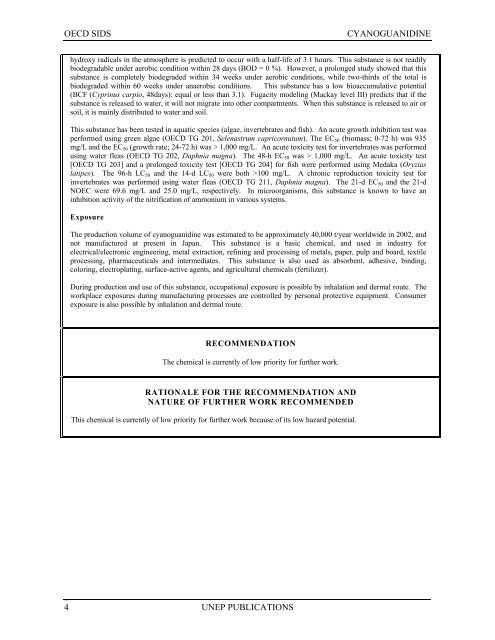Cyanoguanidine CAS N°: 461-58-5
Cyanoguanidine CAS N°: 461-58-5
Cyanoguanidine CAS N°: 461-58-5
Create successful ePaper yourself
Turn your PDF publications into a flip-book with our unique Google optimized e-Paper software.
OECD SIDS<br />
CYANOGUANIDINE<br />
hydroxy radicals in the atmosphere is predicted to occur with a half-life of 3.1 hours. This substance is not readily<br />
biodegradable under aerobic condition within 28 days (BOD = 0 %). However, a prolonged study showed that this<br />
substance is completely biodegraded within 34 weeks under aerobic conditions, while two-thirds of the total is<br />
biodegraded within 60 weeks under anaerobic conditions. This substance has a low bioaccumulative potential<br />
(BCF (Cyprinus carpio, 48days): equal or less than 3.1). Fugacity modeling (Mackay level III) predicts that if the<br />
substance is released to water, it will not migrate into other compartments. When this substance is released to air or<br />
soil, it is mainly distributed to water and soil.<br />
This substance has been tested in aquatic species (algae, invertebrates and fish). An acute growth inhibition test was<br />
performed using green algae (OECD TG 201, Selenastrum capricornutum). The EC 50 (biomass; 0-72 h) was 935<br />
mg/L and the EC 50 (growth rate; 24-72 h) was > 1,000 mg/L. An acute toxicity test for invertebrates was performed<br />
using water fleas (OECD TG 202, Daphnia magna). The 48-h EC 50 was > 1,000 mg/L. An acute toxicity test<br />
[OECD TG 203] and a prolonged toxicity test [OECD TG 204] for fish were performed using Medaka (Oryzias<br />
latipes). The 96-h LC 50 and the 14-d LC 50 were both >100 mg/L. A chronic reproduction toxicity test for<br />
invertebrates was performed using water fleas (OECD TG 211, Daphnia magna). The 21-d EC 50 and the 21-d<br />
NOEC were 69.6 mg/L and 25.0 mg/L, respectively. In microorganisms, this substance is known to have an<br />
inhibition activity of the nitrification of ammonium in various systems.<br />
Exposure<br />
The production volume of cyanoguanidine was estimated to be approximately 40,000 t/year worldwide in 2002, and<br />
not manufactured at present in Japan. This substance is a basic chemical, and used in industry for<br />
electrical/electronic engineering, metal extraction, refining and processing of metals, paper, pulp and board, textile<br />
processing, pharmaceuticals and intermediates. This substance is also used as absorbent, adhesive, binding,<br />
coloring, electroplating, surface-active agents, and agricultural chemicals (fertilizer).<br />
During production and use of this substance, occupational exposure is possible by inhalation and dermal route. The<br />
workplace exposures during manufacturing processes are controlled by personal protective equipment. Consumer<br />
exposure is also possible by inhalation and dermal route.<br />
RECOMMENDATION<br />
The chemical is currently of low priority for further work.<br />
RATIONALE FOR THE RECOMMENDATION AND<br />
NATURE OF FURTHER WORK RECOMMENDED<br />
This chemical is currently of low priority for further work because of its low hazard potential.<br />
4<br />
UNEP PUBLICATIONS
















